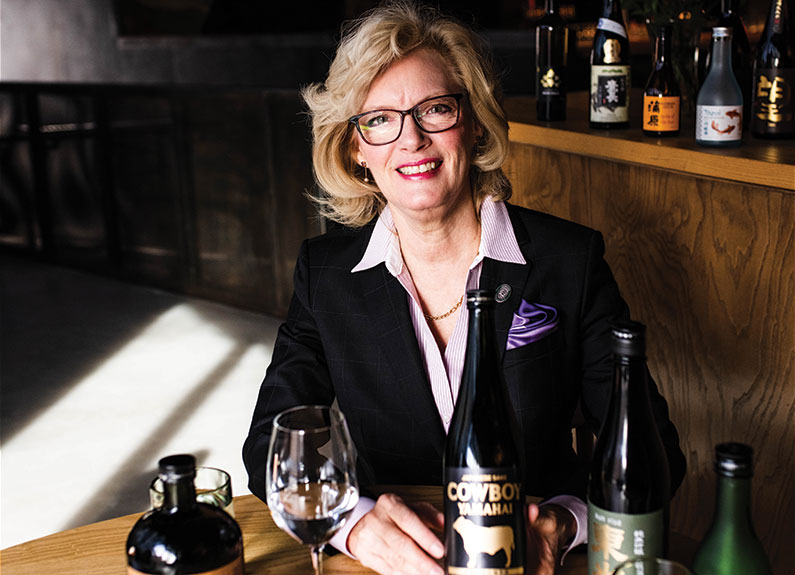
What I Do: Elmwood sommelier Patricia Wamhoff
Sommelier Patricia Wamhoff has been a guiding force in St. Louis’ wine scene for over 20 years. A native of Toronto, Wamhoff holds numerous professional certifications including advanced sommelier from the Court of Master Sommeliers. She is also a certified wine educator through the Society of Wine Educators and has mentored many industry professionals undertaking the certification process. Recently, Wamhoff has turned her interest to sake and received the Wine and Spirit Education Trust Level Three award in sake in August. Here, she discusses her path to certified sommelier status, how St. Louis’ beverage scene has evolved, and why she thinks St. Louis is ready for a sake moment.
“A friend of mine and I were single at the time, and we would get together and do these wine dinners. It was always, ‘What wine are we going to serve?’ So Susan and I said, ‘Let’s take a wine course.’”
“So we took the first one, and our motive was to learn about wine, but also being single, we thought, ‘Hey, there’s single guys there!’ Wrong. It was all couples.”
“We had a great time anyway. We took the next one, and then we took the next one. Then talking to [the instructor], I said, ‘You know, I really like this.’ He said, ‘Well, the culinary school has a sommelier program.’ So I signed up, thinking, ‘Well, I love food. I love travel. I love languages. I love culture.’ So I thought, ‘I’m in.’”
“[After moving to St. Louis,] I started in sales and I met [Annie Gunn’s sommelier] Glenn Bardgett. He has always been involved in the Missouri wine industry, and he said, ‘There’s the Governor’s Cup competition, and you should be a judge.’ Because Ontario has a lot of non-vinifera [hybrid] wines as well, so there’s a real tie-in to understanding what those wines taste like. So I became a judge for that.”
“That was a very different time in the number of wines that were up to the caliber that they should be. It probably would have been 1994. Today, I have no qualms in putting up any of the wines that are winning bronze, silver or gold in the Missouri competition up with any wine in the world.”
“I would come in [to restaurants as a wine sales representative] and say, ‘I’m a sommelier.’ People would say, ‘Well, what’s that?’ And I’d have to explain. And then there were a few that said, ‘How can I do that?’ And so I started mentoring and tutoring to get them at least into the intro level [for certification from the Court of Master Sommeliers].”
“I was a sales rep for A. Bommarito Wines. They were smaller than some of the distributors who had been around longer, but they saw value in wine education. It took a number of years, but their support for helping restaurateurs learn more about wine was important for raising standards for wine locally.”
“And that really just kind of exploded. I was doing a lot of tutoring and mentoring. Between the mid ’90s, up to 2000, the number of people that became certified was quite astonishing. In fact, the Court of Master Sommeliers were saying, ‘What’s going on in St. Louis?’”
“I didn’t do any bread, but I did do a lot of gardening [at the beginning of the pandemic]. I thought, ‘You know what? I saw someone up in Chicago who had taken a sake [course].’ It reminded me, ‘Yeah, I always wanted to get back to that.’ So then I started reading and saw the different courses and then started talking to people.”
“Sake goes with all kinds of foods – [it’s like] Champagne; you can have Champagne anytime during the course of a meal. You can have it chilled, room temperature or warmed up, depending on the sake and what your preference is.”
“I’m going to do this next [course] called Sake Scholar, which I’m quite excited about. This course is about regionality. [Japan’s main island] has a 20-degree latitude difference from north to south – that’s like going from New York to Florida. There’s a huge amount of difference in temperature, topography.”
“[Sakes] aren’t that expensive. You can get expensive ones. But if you don’t mind spending $30 on a bottle of wine, you can get a bottle of sake. And because they come in the small sizes – they come in 300-milliliter, 500-milliliter and 720-milliliter – you can spend $13 on a 300-milliliter.”
“It goes back to what I was saying about wine, what people were able to get as far as the quality wines in St. Louis, because it’s known as a beer town. And now, today, you can get anything you want here. The distributors, there’s so many of them. The selection is so wide now, and it should be the same in sake.”





